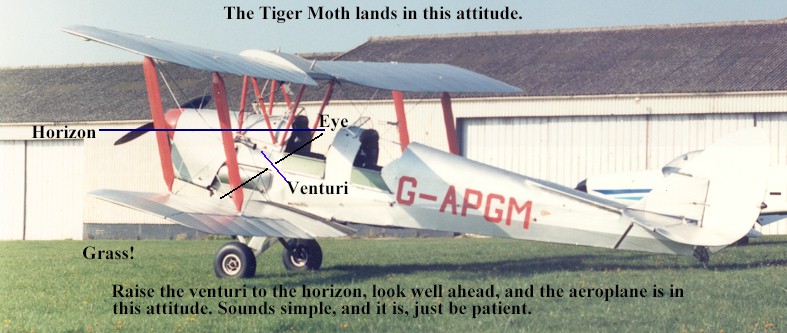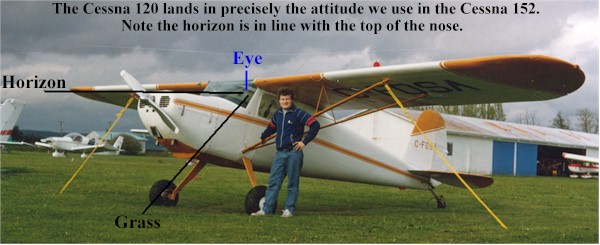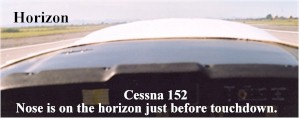
Since we land on the same surfaces as we
takeoff, landings have the same labels: Normal, Short
Field, Soft Field, and Crosswind. The landing is
guaranteed to give you trouble, indeed it gave me a lot of
trouble when I learned!
Landing is a long lesson and so I'm splitting this up into three
pages to cover the subject properly.
There I was...
Bouncing all over the place in a Tiger Moth
(G ACDC) with Geoff Salt doing the best he could to teach me to
land, we did half an hour of not making any progress at all, why
was I so inept and yet I'd flown many hours in tailwheel
aeroplanes?
The first time I flew the Tiger, Ian Senior said: "For
someone who has never flown a Tiger before, you fly it remarkably
well", that was because I had no preconceived ideas about
the Tiger Moth. But after that I listened to all the experts in
the club room... One of the favourites was (imagine upper crust
English accent) "Oh yes, I look straight ahead and let the
World fill my peripheral vision and land the aeroplane...",
how the hell???
I spent a couple of hours trying all the expert ways... then I
had a flash of inspiration over a cup of tea. The Tiger Moth has
been flying since 1933, to have survived it cannot be that bad! I
decided that I would ignore all the clubroom chat and do it my
way. I'm going to stick my head out the left hand side, glance at
the Airspeed Indicator and peg it precisely at 55 KIAS, and then
I'll look well ahead and occasionally over the bottom wing's
leading edge until I saw that we were at the correct hold off
height and then I'd keep the aeroplane flying by looking at the
venturi and slowly bringing it up to the horizon.
I went out again with Geoff Salt, and I did everything I'd
imagined and d'you know what? My landings went from terrible to
excellent.

Like most manoeuvres, landings are subjective. Landings involve a number of actions that result in a gentle touch down. These actions include: setting the aeroplane up at the correct speed on base, and trimming; proper control of the power; appropriate use of the flaps; flaring at the correct height, and then holding off until the correct landing attitude has been achieved.
Normal
In the Pilot's Operating Handbook the Normal Landing is written as follows:
1. Airspeed -- 60-70 KIAS
(flaps up)
2. Wing flaps -- AS DESIRED (below 85KIAS)
3. Airspeed -- 55-65 KIAS (flaps DOWN)
4. Touchdown -- MAIN WHEELS FIRST
5. Landing Roll-- LOWER NOSE WHEEL GENTLY
6. Braking -- MINIMUM REQUIRED
Most pilots will tell you that a good landing follows a good
approach; I agree with this sentiment. A bad approach can be
turned into a good landing by an experienced pilot, like your
instructor, but this sort of approach increases the level of
difficulty enormously for the student pilot. So let's set the
aeroplane up for a consistent approach, consistency enables you
to correct problems during subsequent attempts, inconsistency
leads to different circumstances that require a whole variety of
corrections.
Speed control is important so let's ensure that the aeroplane is
trimmed for the approach speed while on the base leg. I usually
reduce the speed to 65 KIAS at the end of the downwind leg, after
my wingtip reaches the end of the runway. To do this I reduce
power to 1700 RPM, apply Carb' heat, and maintain my height. When
the speed reaches 65, trim, and it's time to turn base.
On base I determine whether I'm going to use flaps or not. Some
instructors consider flap use to be complicated and prefer to
teach flapless landings first, other instructors teach full flap
landings from the start, I prefer to teach the sensible use of
flaps as and when required. This time however we will use 20
degrees of flap, this gives us an excellent view of the approach
path, and a nice short hold-off time. I like to get the landing
over with, floating for long periods gives you much more time to
make mistakes!
On base I reduce the power and apply the flaps, speed at 60 KIAS,
and TRIM! Reduce the power in stages, 1700, 1500, 1200, and then
closed; doing this will avoid cooling the engine too quickly on
cold days and so extend its life.
The power reduction takes place on base as well as when we are
established on finals, on these legs we are using judgement to
ensure a steady approach path to the runway. On the final
approach we are looking for the point of zero movement, this is
the point on the runway that we will hit if we forget to flare,
it should be near to where we wish to touch down. If this point
moves upwards in the windscreen, we will undershoot it and so we
add a little power, if this point moves down the windscreen we
will overshoot it and so we will have to reduce the power. The
aviators ideal is a power off glide to an aiming point on the
ground, but in your initial training we are looking for a steady
approach and so we'll use power to ensure a consistent approach
angle is maintained.
Now the flare! this takes judgement and so you'll have to watch
the instructor's demonstration very carefully. You'll look in
about the 11 o'clock position to verify your height, and then you
will look well ahead to ensure you maintain alignment with the
runway as you hold off. Height judgement is subjective, everyone
of us has to learn our own way of judging this, relating the view
of the ground as we taxy out to being a few feet above it.
Do you remember slow flight? As the aeroplane slowed down we had
to raise the nose to maintain our height. Here we are just inches
above the runway and we try to maintain this height, so we have
to raise the nose as the speed reduces, this is called holding
off. We hold off until the nose reaches the climb attitude, and
then we maintain this attitude until the wheels caress the
ground.


When it goes wrong!
If you don't screw up you're not human... Instructors hate it when a student does it perfectly every time because they need to see that you can correct a bad landing or go around as the circumstances require.
The most common fault is flaring too high. If you flare far too high! Apply power and go around again. If you are a little too high, the cure is to apply some power maintain the attitude and allow the aeroplane to descend gently to the ground. Pay attention to what the ground looks like as the wheels touch down, and put this into your memory for the next effort.
Your instructor will react if you are going to flare too low, it's called self preservation!
Ballooning is the next fault. This is where the control column has been pulled back too quickly such that the aeroplane rises. If it's a low balloon, maintain your attitude until the aeroplane sinks to the hold-off height and then continue to ease it back until you achieve the climb attitude. If you balloon dramatically, apply power and go around.
If you flare too high or balloon and do nothing the aeroplane will bounce due to a high rate of descent to the ground... If you feel the seat falling out from below you, apply some power to cushion the touchdown, or full power and go around.
If you flare and then not hold off, all three wheels will hit the ground or worse you will land on the nosewheel. The nose leg is not as strong as the main undercarriage legs and so an elevator is fitted to protect it, use the elevator to hold off such that the mainwheels touch down gently, and the nose wheel is held off.
Be patient, it takes more than a few circuits to learn to do consistent good landings.
Next: Lesson 14, Short Field, and Soft Field landings.
© Michael Peare 2002